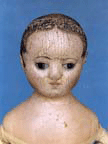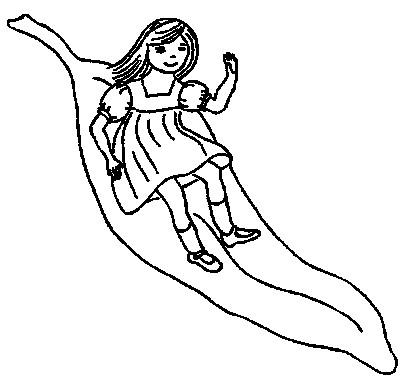

Izannah Walker Dolls
by Lolly Yocum
11/15/99
Izannah F. Walker, one of America's earliest known female doll makers, was born in 1817 in Bristol, Rhode Island. On June 28, 1873, at the age of 56, Walker applied for a patent for "improvement in the manufacture of dolls." In her application Walker claimed "my doll is inexpensive, easily kept clean, and not apt to injure a young child which may fall upon it. It will preserve its appearance for a long time."1 As witnessed by the surviving examples of her work, we know that this is true. Izannah was granted a patent on November 4, 1873. However, it is known that she had been making dolls for quite some time before she applied for her patent. Research has uncovered a documented case of her making dolls as early as 1828:
"From Philomena Hart's Column in the Providence Bulletin.
Mrs. N.M.R. (Norma H. Robertson, grand-niece of Miss Walker) wrote me a fascinating account of a doll which she thinks is the predecessor of the Chase doll of Pawtucket. It was made in Central Falls by Miss Izannah Walker.(1817-1888) She was the aunt of my correspondent who says of her, "Always inventive, she had created a stockinette doll as early as 1848 when my mother was a little child in New London, Conn. Family tradition tells of her struggle to perfect her work and of the long wrestling with one problem, how to obtain a resistant surface to the stockinette heads, arms, and legs, without cracking or peeling. With this problem on her mind, Aunt Izannah suddenly sat up in bed one night to hear a voice say "use paste." It worked... Aunt Izannah always deplored the fact that she was not a man. However, she made dolls and doll furniture, tinkered with household gadgets, designed a parlor heater, "that beat Ben Franklins," raised canaries, dabbled in real estate, and was looked upon with admiration by male contemporaries because of her skill with carpenters' tools, so perhaps she was resigned."2
A Mrs. Singsen, intrigued by this letter, contacted Mrs. Robertson to learn more and received the following information:
"The Walker family came to Central Falls in Somerset Mass., and the first dolls were made for friends. One, owned by the family and now out west, is one of the very earliest and is practically life sized. Izannah Walker had three sisters, and as the business began to develop she put them to work painting the dolls faces. There were also darky dolls made, but these Mrs. Robertson said, had wool hair instead of painted on hair. From 1845, when the first doll is said to have been made,until she died in 1886, Izannah Walker carried on the business, not securing a patent until persuaded to do so by friends in 1873."3
According to the patent laws in 1873 it would have been illegal for Izannah to have been making dolls for more than two years before applying for her patent. Also note the two different years stated for Izannah's death.
Izannah Walker's dolls are three dimensional works of art, strikingly similar to the folk portraits painted in the 18th and early 19th century by artists such as William Matthew Prior (1806-1873) and Erastus Salisbury Field (1805-1900). Although all of Izannah's dolls possess a recognizable style, each is distinct. This raises the question of whether some were done as portrait dolls. Although there is no documentation of this, the differences in height, facial shapes, and hairstyles on the dolls could certainly cause one to speculate that this is possible. Her dolls have been found in 15, 17, 18, 20, 21, and 24 inch sizes. The hair is usually painted on with some variation of either wisps surrounding the face or corkscrew curls. Most of the dolls are girls but several boys have been found and photographed. Izannah also made black dolls as mentioned above in Mrs. Singsen's letter. The dolls hands have stitched fingers and applied thumbs and the feet are either bare, with stitched toes, or they have painted on boots.
Today the rarity and beauty of Izannah Walker dolls make them highly collectible. Currently the price range for these dolls, in good condition, can go from $16,000-18,000.4
Footnotes
1 Izannah Walker, "Patent Number 144, 373, November 4, 1873", United States Patent Office, Washington, D.C.
2 Janet Pagter Johl, Your Dolls And Mine A Collectors Handbook (New York: H. L. Lindquist Publications 1952), pgs.37-38.
3 Janet Pagter Johl, Your Dolls And Mine A Collectors Handbook (New York: H. L. Lindquist Publications 1952), pgs.38-39.
4 Jan Foulke, 14th Blue Book Dolls and Values. (Cumberland, MD: Hobby House Press, 1999), p. 200.
Bibliography
Coleman, Dorothy S., Elizabeth A., and Evelyn Jane. The Collector's Encyclopedia of Dolls. New York: Crown Publishers, Inc. 1968
Foulke, Jan. 14th Blue Book Dolls and Values. Cumberland, MD: Hobby House Press, 1999.
Fox, Carl. The Doll. New York. Harry Abrams, Inc. 1973.
Johl, Janet Pagter. Your Dolls and Mine A Collectors Handbook. New York: H.L. Lindquist Publications 1952.
McGonagle, Dorothy A. A Celebration of American Dolls from the Collection of the Strong Museum. Cumberland, MD: Hobby house Press, 1997
 |
©Laurelleaf Studios 2004 |